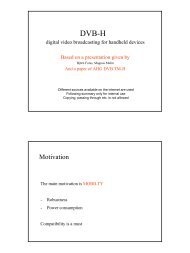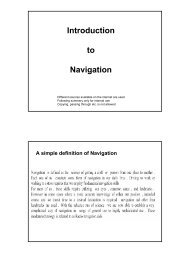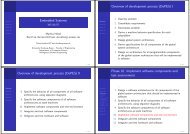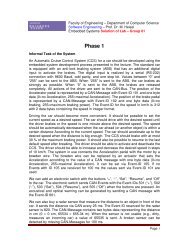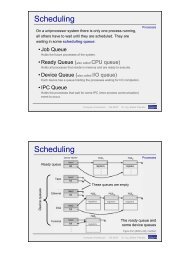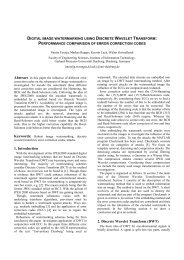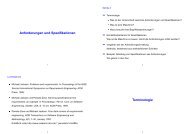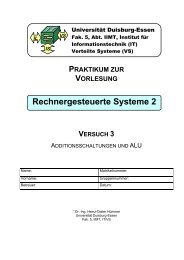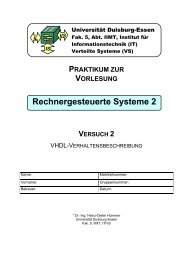Design Patterns
Design Patterns
Design Patterns
You also want an ePaper? Increase the reach of your titles
YUMPU automatically turns print PDFs into web optimized ePapers that Google loves.
<strong>Design</strong> <strong>Patterns</strong><br />
DESIGN PATTERNS: CHARACTERIZED BY<br />
➠ usage for detailed design<br />
➠ object-oriented paradigm<br />
➠ “Description of a family of solutions for a software design problem” (Tichy)<br />
Class<br />
Class Class<br />
1<br />
Class Structuring of architectural components<br />
3<br />
CONTENT OF THE LECTURE<br />
1. Introduction<br />
2. Software process models<br />
3. Requirements engineering<br />
(a) Requirements and specifications<br />
(b) Problems and subproblems<br />
(c) Problem Frames<br />
(d) Specifications for subproblems<br />
4. <strong>Design</strong><br />
(a) Software architectures<br />
(b) <strong>Design</strong> patterns<br />
(c) <strong>Design</strong> by Contract<br />
5. Implementation<br />
(a) Development of correct algorithms<br />
6. Quality assurance<br />
(a) Testing<br />
LITERATURE<br />
Erich Gamma, Richard Helm, Ralph Johnson and John Vlissides.<br />
<strong>Design</strong> <strong>Patterns</strong> – Elements of Reusable Object-Oriented Software.<br />
Addison Wesley, 1995.<br />
(“Gang of Four”, GoF)<br />
John Vlissides.<br />
Pattern Hatching – <strong>Design</strong> <strong>Patterns</strong> Applied.<br />
Addison Wesley, 1998.<br />
2<br />
4
EXAMPLE<br />
Notation: UML Class Diagrams<br />
Professor Institute<br />
1 Leads 0..1<br />
name<br />
name<br />
specialty<br />
director<br />
0..2<br />
Gives<br />
*<br />
Course<br />
title<br />
4..6 Takes 3..*<br />
Student<br />
name<br />
participant inscription_number<br />
5<br />
mulitplicity reading direction<br />
7<br />
role<br />
association name<br />
OBJECT<br />
➠ Abstraction of a real thing, concept or issue.<br />
➠ Has a local state in the form of attributes.<br />
➠ Has a unique identity.<br />
➠ Has behavior defined by a set of operations.<br />
CLASS<br />
➠ Abstraction of a set of uniform objects.<br />
➠ Template for objects (instances).<br />
➠ Defines operations and attributes for its objects.<br />
➠ Corresponds to a type.<br />
DIFFERENT NOTATIONS FOR CLASSES<br />
or or<br />
Class Class Class<br />
a1: T1<br />
a2 : T2<br />
MEANING OF THE CLASS DIAGRAM<br />
6<br />
a1: T1<br />
a2 : T2<br />
➠ Each institute has exactly one professor who leads it.<br />
➠ This professor is called ”director”.<br />
➠ A professor leads at most one institute.<br />
➠ A professor can give course, but need not do so.<br />
op1(p: T1) : T2<br />
➠ Each course is given by at most two professors (also zero professors are<br />
possible).<br />
➠ A student takes four to six courses.<br />
➠ There, he is a “participant”.<br />
➠ A course has to be taken by at least three students.<br />
8
ASSOCIATIONS<br />
➠ denote the relations between objects<br />
➠ are drawn as links between classes<br />
➠ can have an arity of more than two<br />
➠ can have names (convention: use capital letters)<br />
➠ can have multiplicities<br />
➠ can have role names<br />
ROLE NAMES<br />
➠ are written at the ends of the links<br />
➠ per convention, role names are written in small letters<br />
Person<br />
1..*<br />
child<br />
9<br />
IsChildOf<br />
11<br />
parent<br />
2<br />
ASSOCIATIONS WITH ARITY GREATER THAN TWO<br />
Associations can exist between more than two classes.<br />
MULTIPLICITIES<br />
Student Exam<br />
Room<br />
Writes<br />
➠ express cardinality constraints of relations<br />
10<br />
➠ for each object of o of Class2, there exist m objects o ′ of Class1, such that<br />
o and o ′ are in relation Rel.<br />
Notation:<br />
Class1<br />
Rel<br />
Class2<br />
m<br />
• number n: exactly n objects<br />
• scope i..j<br />
• * : any number, also 0<br />
• i..∗ : at least i<br />
• ∗..j : at most j<br />
• not specified : means *<br />
• 0..1, 3..4, 6..∗ :<br />
12<br />
all quantities except 2 and 5
ASSOCIATION CLASSES<br />
➠ Associations can also have attributes.<br />
➠ Reasonable, if the attributes cannot be assigned to any of the classes<br />
involved in the association.<br />
Writes<br />
Student Exam<br />
Writes<br />
mark<br />
GENERALIZATION/SPECIALIZATION<br />
➠ Classes correspond to types.<br />
➠ Subclasses correspond to subtypes, not subsets.<br />
➠ Specialization = ”is a” , but ”behaves as” , ”is a kind of”<br />
BachelorCourse MasterCourse<br />
subject<br />
13<br />
Course Personnel Student<br />
Constraint<br />
title<br />
name<br />
name<br />
pers.nr<br />
inscription_number<br />
salary<br />
{complete}<br />
specialization<br />
15<br />
Professor TeachingAssistent<br />
specialty<br />
AGGREGATION AND COMPOSITION<br />
are special associations.<br />
Room<br />
Wall<br />
The wall is a part of the room.<br />
If a part belongs to a whole and can only exist with that whole, then this is a<br />
composition relation.<br />
CONSTRAINTS<br />
Window<br />
Frame<br />
or<br />
➠ Are conditions that must hold.<br />
➠ Are written between “{}”.<br />
14<br />
Window<br />
Frame<br />
➠ The example: “{complete}” means that no other subclasses of Course<br />
can exist.<br />
➠ Meaning of constraints must be described informally.<br />
16
Classifying, Describing, and Using <strong>Design</strong> <strong>Patterns</strong><br />
TYPES OF DESIGN PATTERNS (TICHY)(1)<br />
• Coupling/decoupling patterns<br />
17<br />
System is divided into units that can be changed independently from each<br />
other<br />
e.g. Iterator, Facade, Proxy<br />
• Unification patterns<br />
Similarities are extracted and only described at one place.<br />
e.g. Composite, Abstract Factory<br />
• Data-structure patterns<br />
Process states of objects independently of their responsibilities<br />
e.g. Memento, Singleton<br />
19<br />
TYPES OF DESIGN PATTERNS (GOF)<br />
• creational<br />
concern the process of object creation<br />
• structural<br />
deal with the composition of classes or objects<br />
• behavioral<br />
characterize the ways in which classes or objects interact and distribute<br />
responsibility<br />
Second criterion: scope<br />
specifies whether the pattern applies primarily to classes or to objects.<br />
TYPES OF DESIGN PATTERNS (TICHY)(2)<br />
• Control flow patterns<br />
18<br />
Influence the control flow; provide for the right method to be called at the<br />
right time<br />
e.g. Strategy, Visitor<br />
• Virtual machines<br />
Receive programs and data as input, execute programs according to data<br />
e.g. Interpreter<br />
(Remark: no clear boundary to architectural styles)<br />
20
ADVANTAGES OF DESIGN PATTERNS (TICHY)<br />
• Improvement of team communication<br />
<strong>Design</strong> pattern as “short formula” in discussions<br />
• Compilation of essential concepts, expressed in a concrete form<br />
• Documentation of the “state of the art”<br />
Help for less experienced designers, not constantly reinventing the wheel<br />
• Improvement of the code quality<br />
Given structure, code examples<br />
DESCRIPTION OF DESIGN PATTERNS (GOF) (2)<br />
Collaborations How do the participants collaborate to carry out their<br />
responsibilities?<br />
Consequences What are the trade-offs and results of using the pattern?<br />
What aspect of system structure does it let one vary independently?<br />
Implementation What pitfalls, hints, or techniques should one be aware of<br />
21<br />
when implementing the pattern? Are there any language-specific issues?<br />
Sample Code Code fragments in C ++ or Smalltalk.<br />
Known Uses At least two examples of applications taken from existing<br />
systems of different fields.<br />
Related <strong>Patterns</strong> Similar patterns and patterns that are often used in<br />
combination with the described pattern.<br />
23<br />
DESCRIPTION OF DESIGN PATTERNS (GOF) (1)<br />
Name and Classification A good name is important, because it will become<br />
part of the design vocabulary.<br />
Intent What does the pattern do? Which problems does it solve?<br />
Also Known As Other familiar names.<br />
Motivation Scenario which illustrates the design problem and how the pattern<br />
solves the problem.<br />
Applicability What are the situations in which the design pattern can be<br />
applied? How can one recognize these situations?<br />
Structure Class and interaction diagrams.<br />
Participants Classes and objects, which are part of the pattern, as well as<br />
their responsibilities.<br />
MODEL-VIEW-CONTROLLER (MVC)<br />
• Architectural Style a /<strong>Design</strong> Pattern b -Hybrid<br />
• aggregate design pattern out of<br />
– Composite<br />
– Observer<br />
– Strategy<br />
– Factory Method<br />
22<br />
• Clear distinction of data (model), data representation on a screen (view)<br />
and control of data manipulation or views (controller)<br />
a Buschmann et al. – Pattern-Oriented Software Architecture – A System of <strong>Patterns</strong>, John<br />
Wiley & Sons, 1996.<br />
b GoF<br />
24
HOW MVC WORKS – AN OVERVIEW<br />
MVC CLASS DIAGRAM<br />
call update<br />
Model<br />
coreData<br />
setOfObservers<br />
attach(Observer)<br />
detach(Observer)<br />
notify<br />
getData<br />
service<br />
View(s)<br />
Model<br />
attach<br />
getData<br />
View<br />
25<br />
myModel<br />
myController<br />
initialize(Model)<br />
makeController<br />
activate<br />
display<br />
update<br />
create<br />
manipulate<br />
display<br />
attach<br />
call service<br />
Observer<br />
update<br />
User<br />
Controller<br />
Controller<br />
myModel<br />
myView<br />
initialize(Model,View)<br />
handleEvent<br />
update<br />
• Model: does not know View or Controller beforehand, announces change by<br />
calling update, related components request model state by getData, if needed<br />
keep data in a data base<br />
• View: connected to Model, displays data (visually, acoustically, or similar)<br />
normally on a screen<br />
• Controller: administrates Views, manipulates data on behalf of the user, ”brain” of<br />
the application<br />
27<br />
DESCRIPTION OF MVC, TRYGVE M. H. REENSKAUG<br />
Intent Interactive applications with a flexible human-computer interface.<br />
Motivation Adaptability and Reuse<br />
Participants MVC seperates the application into three (independent)<br />
components<br />
• Model offers core functionality a and data<br />
• View provides information to the user<br />
• Controller handles user input<br />
• All three components are related by a change-propagation mechanism.<br />
• View and Controller constitute the user interface.<br />
a stable, because it is related to requirements<br />
26<br />
<strong>Design</strong> <strong>Patterns</strong> of MVC in detail<br />
28
EXAMPLE: “COMPOSITE”<br />
Classification object/structural<br />
Intent Compose objects into tree structures to represent part-whole<br />
hierarchies. Composite lets you treat individual objects and compositions<br />
of objects uniformly.<br />
Also Known As —<br />
Motivation Users can build complex diagrams out of simple components by<br />
using graphics applications.<br />
Problem: Code that uses the corresponding classes must treat primitive<br />
and container objects differently, even if most of the time the user treats<br />
them identically. The Composite pattern describes how a recursive<br />
composition can be designed so that the client does not have to distinguish<br />
between primitive objects and containers.<br />
Applicability Use the Composite pattern when<br />
• you want to represent part-whole hierarchies of objects.<br />
29<br />
• you want clients be able to ignore the difference between compositions<br />
of objects and individual objects. Clients will treat all objects in the<br />
composite structure uniformly.<br />
Structure (abstract classes and operations are noted in italics)<br />
Leaf<br />
operation()<br />
Component<br />
operation()<br />
getChild(int)<br />
31<br />
*<br />
Composite<br />
operation()<br />
getChild(int)<br />
children<br />
Example:<br />
aPicture<br />
aPicture aLine aRectangle<br />
aText aLine aRectangle<br />
common operations: draw(), move(), delete(), scale()<br />
Participants<br />
• Component (graphic)<br />
– declares the interface for objects in the composition<br />
30<br />
– implements default behavior for the interface common to all classes,<br />
as appropriate<br />
– declares an interface for accessing and managing its child<br />
components<br />
– (optional) defines an interface for accessing a component’s parent in<br />
the recursive structure, and implements it if that’s appropriate<br />
• Leaf (rectangle, line, text etc.)<br />
– represents leaf objects in the composition. A leaf has no children.<br />
– defines behavior for primitive objects in the composition<br />
32
• Composite (picture)<br />
– defines behavior for components having children<br />
– stores child components<br />
– implements child-related operations in the Component interface<br />
• Client (not contained in the class diagram)<br />
– manipulates objects in the composition through Component interface<br />
Collaborations Clients use the Component class interface to interact with<br />
objects in the composite structure. If the recipient is a leaf, then the<br />
request is handled directly. If the recipient is a composite, then it usually<br />
forwards the request to its child components, possibly performing<br />
additional operations before and/or after forwarding.<br />
• makes it easier to add new kinds of components.<br />
33<br />
Newly defined subclasses of Composite or Leaf work automatically<br />
with existing structures and client code. Clients don’t have to be<br />
changed for new component classes.<br />
• can make your design overly general<br />
The disadvantage of making it easy to add new components is that it<br />
makes it harder to restrict the components of a composite. Sometimes<br />
you want a composite to have only certain components. With<br />
Composite, you can’t rely on the type system to enforce those<br />
constraints for you. You’ll have to use run-time checks instead.<br />
35<br />
Consequences The Composite pattern<br />
• defines class hierarchies consisting of primitive objects and composite<br />
objects.<br />
Whenever client code expects a primitive object, then it can also take a<br />
composite object.<br />
• makes the client simple<br />
Clients can treat composite structures and individual objects uniformly.<br />
Clients normally don’t know (and shouldn’t care) whether they’re<br />
dealing with a leaf or a composite object. This simplifies client code,<br />
because it avoids having to write tag-and-case-statement-style<br />
functions over the classes that define the composition.<br />
Implementation GoF considers the following aspects:<br />
1. Explicit parents references<br />
Should be defined in the Component class.<br />
2. Sharing components<br />
34<br />
Can be useful to reduce storage requirements, but destroys tree<br />
structure.<br />
3. Maximizing the Component interface<br />
Necessary to make clients unaware of the specific Leaf or Composite<br />
classes they are using. Default implementation in Component can be<br />
overwritten in subclasses.<br />
36
4. Declaring the child management operations<br />
Declaration of add- and remove-operations in the class Component<br />
results in transparency; all components can be treated uniformly. Costs<br />
safety, because meaningless operations can be called, e.g. adding to<br />
objects to leafs.<br />
Defining child management in the Composites class gives safety, but is<br />
at the expense of transparency (leaves and composites have different<br />
interfaces).<br />
5. Should Component implement a list of components?<br />
Incurs a space penalty for every leaf.<br />
6. Child ordering<br />
When child ordering is an issue, applying the Iterator pattern is<br />
recommended.<br />
Sample Code Equipment such as computers and stereo components are<br />
often organized into part-whole or containment hierarchies.<br />
37<br />
class Equipment {<br />
public:<br />
virtual ˜Equipment();<br />
const char* Name() { return _name; }<br />
virtual Watt Power();<br />
virtual Currency NetPrice();<br />
virtual Currency DiscountPrice();<br />
virtual void Add(Equipment*);<br />
virtual void Remove(Equipment*);<br />
virtual Iterator* CreateIterator();<br />
protected:<br />
Equipment(const char*);<br />
private:<br />
const char* _name;<br />
};<br />
39<br />
7. Caching to improve performance<br />
Useful, if the compositions have to be traversed or searched frequently.<br />
8. Who should delete components?<br />
In languages without garbage collection, it’s usually best to make a<br />
composite responsible for deleting its children when it’s destroyed.<br />
9. What’s the best data structure for storing components?<br />
Depends on aspects of efficiency.<br />
Equipment declares operations that return the attributes of a piece of<br />
equipment, like its power consumption and cost. A<br />
CreateIterator-operation returns an iterator for accessing its parts.<br />
Further classes such as FloppyDisk as class for leaves and<br />
CompositeEquipment for composite equipment are defined in the<br />
GoF-book.<br />
38<br />
40
Known Uses<br />
• View-class in Model/View/Controller<br />
• Composite structure for parse trees<br />
• portfolio containing assets<br />
Related <strong>Patterns</strong><br />
• Often the component-parent link is used for a Chain of Responsibility.<br />
• Decorator is often used with composites. When decorators and<br />
composites are used together, they will usually have a common parent<br />
class.<br />
• Flyweight lets you share components, but they can no longer refer to<br />
their parents.<br />
• Iterator can be used to traverse composites.<br />
• Visitor localizes operations and behavior that would otherwise be<br />
distributed across Composite and Leaf classes.<br />
REQUIREMENTS (1)<br />
• File system should be able to handle file structures of any size and<br />
complexity.<br />
• Directories and (basic) files should be distinguished.<br />
41<br />
• The code, e.g. for selecting the name of a directory should be the same as<br />
for files. The same holds for size, access rights, etc.<br />
• It should be easy to add new types of files (e.g. symbolic links).<br />
43<br />
Example<br />
User Interface of a File System<br />
APPLICATION OF THE COMPOSITE PATTERN<br />
Node<br />
getChildren()<br />
read()<br />
write()<br />
add()<br />
remove()<br />
42<br />
getName()<br />
getProtection()<br />
getChildren()<br />
read()<br />
write()<br />
add()<br />
remove()<br />
File Directory<br />
*<br />
getChildren()<br />
read()<br />
write()<br />
add()<br />
remove()<br />
44<br />
children
REQUIREMENTS (2)<br />
• When the name of a file or directory is changed (setName), the<br />
representation of the name on the display will be updated, too.<br />
Applicability Use the Observer pattern when<br />
• change to one object requires changing others,<br />
and you do not know how many objects need to be changed.<br />
• an object should be able to notify other objects without making<br />
assumptions about who these objects are.<br />
45<br />
47<br />
EXAMPLE: “OBSERVER”<br />
Classification object/behavioral<br />
Intent Define a one-to-many dependency between objects so that when one<br />
object changes state, all its dependents are notified and updated<br />
automatically.<br />
Also Known As Dependents, Publish-Subscribe<br />
Structure<br />
Subject<br />
Attach(Observer)<br />
Detach(Observer)<br />
Notify()<br />
ConcreteSubject<br />
subjectState<br />
GetState()<br />
SetState()<br />
observers<br />
46<br />
48<br />
subject<br />
Observer<br />
Update()<br />
ConcreteObserver<br />
observerState<br />
Update()
Participants<br />
• Subject<br />
– knows its observers<br />
– provides an interface for attaching and detaching Observer objects<br />
• Observer<br />
– defines an update interface for objects that should be notified of<br />
changes in a subject<br />
APPLICATION OF THE OBSERVER PATTERN<br />
Subject<br />
Attach(Observer)<br />
Detach(Observer)<br />
Notify()<br />
File<br />
GetName()<br />
SetName()<br />
observers<br />
49<br />
Observer<br />
Update()<br />
concreteSubject concreteObserver<br />
filename subject obsStateOfFilename<br />
51<br />
Display<br />
Update()<br />
• ConcreteSubject<br />
– stores state of interest to ConcreteObserver object<br />
– sends a notification to its observers when its state changes<br />
• ConcreteObserver<br />
– maintains a reference to a ConcreteSubject object<br />
– stores state that should stay consistent with the ConcreteSubject’s<br />
– implements the update-interface of Observer<br />
Related <strong>Patterns</strong> Mediator, Singleton<br />
REQUIREMENTS (3)<br />
• It is not allowed to delete directories which include files or are write<br />
protected.<br />
50<br />
52
EXAMPLE: “STRATEGY”<br />
Classification object/behavioral<br />
Intent Define a family of algorithms, encapsulate each one, and make them<br />
interchangeable. Strategy lets the algorithm vary independently from<br />
clients that use it.<br />
Also Known as Policy<br />
Structure<br />
Context<br />
ContextInterface()<br />
strategy<br />
ConcreteStrategyA<br />
AlgorithmInterface()<br />
53<br />
Strategy<br />
AlgorithmInterface()<br />
ConcreteStrategyB<br />
AlgorithmInterface()<br />
55<br />
ConcreteStrategyC<br />
AlgorithmInterface()<br />
Applicability Use the Strategy pattern when<br />
• many related classes differ only in their behavior. Strategy provides a<br />
way to configure a class with one of many behaviors.<br />
• you need different variants of an algorithm.<br />
• an algorithm uses data that clients should not know about.<br />
• a class defines many behaviors, and these appear as multiple<br />
Participants<br />
conditional statements in its operations.<br />
• Strategy<br />
54<br />
– declares an interface common to all supported algorithms. Context<br />
uses this interface to call algorithm defined by a ConcreteStrategy.<br />
• ConcreteStrategy<br />
– implements the algorithm using the Strategy interface.<br />
• Context<br />
– is configured with a ConcreteStrategy object<br />
– may define an interface that lets Strategy access its data<br />
Related <strong>Patterns</strong> Flyweight<br />
56
APPLICATION OF THE STRATEGY PATTERN<br />
Directory<br />
DirectoryInterface()<br />
strategy<br />
ConcreteStrategyA<br />
deleteDirectory()<br />
EXAMPLE: “FACTORY METHOD”<br />
Classification creational<br />
Strategy<br />
deleteDirectory()<br />
ConcreteStrategyB<br />
deleteDirectory()<br />
ConcreteStrategyC<br />
deleteDirectory()<br />
isEmpty() !isEmpty() isProtected()<br />
Intent Define an interface for creating an object, but let subclasses decide<br />
which class to instantiate.<br />
Also Known As Virtual Constructor<br />
57<br />
59<br />
REQUIREMENTS (4)<br />
• The file system offers the creation of files, where the kind of file to be<br />
created (.txt, .ods, .xls) depends on the particular application.<br />
Applicability Use the Factory Method pattern when<br />
• a class cannot anticipate the class of objects it must create.<br />
• a class wants its subclass to specify the object it creates.<br />
58<br />
• classes delegate responsibility to one of several helper subclasses, and<br />
you want to localize the knowledge of which helper subclass is the<br />
delegate.<br />
60
Structure<br />
Product<br />
ConcreteProduct<br />
<br />
61<br />
Creator<br />
FactoryMethod()<br />
AnOperation()<br />
ConcreteCreator<br />
FactoryMethod()<br />
AnOperation()<br />
APPLICATION OF THE FACTORY METHOD PATTERN<br />
Files<br />
Open()<br />
Close()<br />
Save()<br />
<br />
Text−File OpenOffice<br />
63<br />
Application<br />
CreateFiles()<br />
NewFiles()<br />
OpenFiles()<br />
CreateFiles()<br />
Participants<br />
• Product (Files)<br />
– defines the interface of objects the FactoryMethod() creates<br />
• ConcreteProduct (Text-File)<br />
– implements the Product interface<br />
• Creator (Application)<br />
– declares the FactoryMethod(), which returns an object of type<br />
Product<br />
• ConcreteCreator (Open Office)<br />
– overrides the FactoryMethod() to return an instance of a<br />
ConcreteProduct<br />
Related <strong>Patterns</strong> Abstract Factory, Template Method, Prototypes<br />
WHAT HAVE WE LEARNT?<br />
➠ <strong>Design</strong> patterns are object oriented patterns at detailed design level.<br />
➠ They are closer to implementation than architectural styles.<br />
➠ According to the GoF classification, there are behavioral, creational and<br />
structural patterns.<br />
➠ <strong>Design</strong> patterns support achieving desirable properties in implementing<br />
62<br />
object-oriented software, e.g. independent modification of parts, limitation<br />
of communication paths etc.<br />
64
➠ We have presented and used the following patterns for MVC:<br />
1. Composite<br />
2. Observer<br />
3. Strategy<br />
4. Factory Method<br />
65



